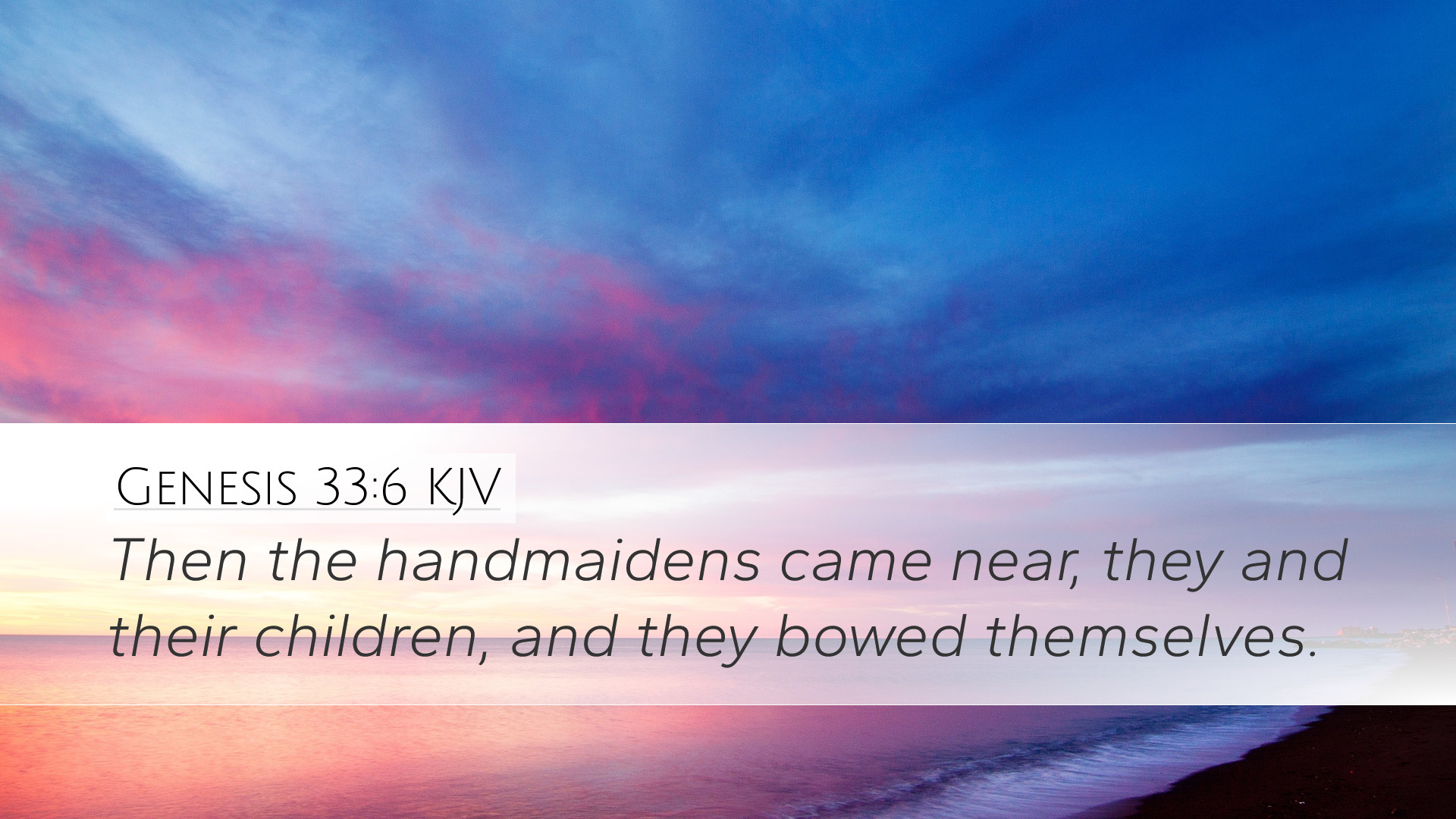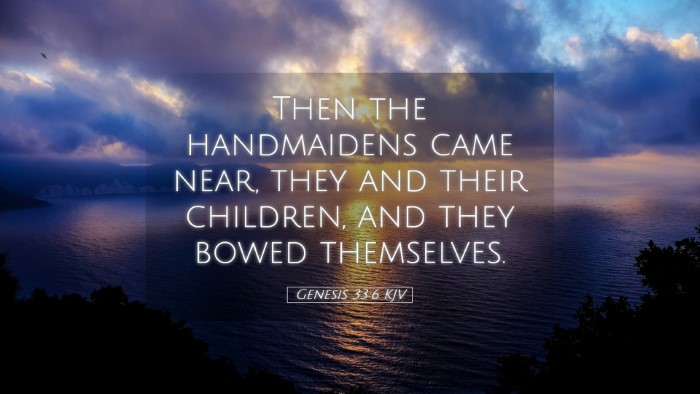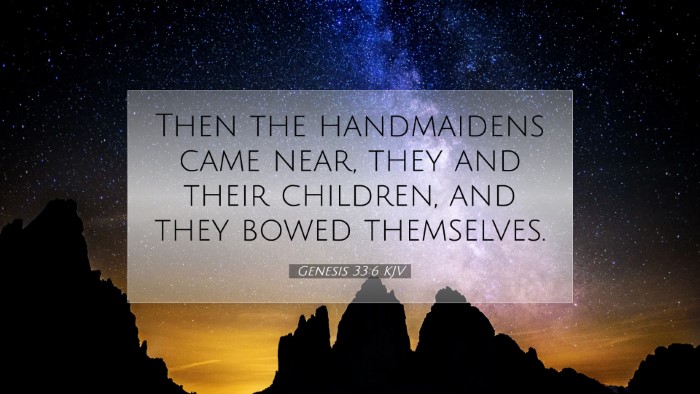Commentary on Genesis 33:6
Verse Reference: Genesis 33:6 - "Then the handmaidens came near, they and their children, and they bowed themselves."
Contextual Background
In order to grasp the full significance of Genesis 33:6, it is essential to consider the preceding events in the life of Jacob. Having deceived his father and obtained the blessing meant for his brother Esau, Jacob fled to Haran, where he worked for Laban. After twenty years of service, Jacob returned to Canaan, driven by God’s command and motivated by the desire to reconcile with Esau. As he approached his brother’s territory, Jacob was filled with trepidation regarding Esau’s potential wrath, leading him to prepare for the encounter meticulously.
Analysis of Genesis 33:6
This verse illustrates a significant moment in Jacob's journey. The arrival of the handmaidens with their children is not just a familial conjunction; it represents the layers of relationships, reconciliations, and the complexities of Jacob's life.
-
Symbolism of Submission:
The act of bowing illustrates a posture of submission, which is a recurring theme in Jacob's life. The handmaidens, Leah and Rachel's servants, who bore children for Jacob, demonstrate their loyalty and understanding of social hierarchies of the time. Their act serves to honor Esau and underscore the humility that comes with seeking reconciliation.
-
Community and Family Dynamics:
The structure of Jacob's family is intricate, consisting of four women and many children. Each woman's contribution to his family unit signifies the varied relationships that shaped his identity. In this encounter, their presentation to Esau shows that Jacob's return is not merely about his reconciliation with Esau but also about acknowledging the broader family community.
-
Preparation for Encounter:
The deliberate arrangement of which family members approached Esau illustrates Jacob's strategic thinking. He places those who are most vulnerable (the servants and their children) before himself, indicating his desire to protect and prioritize his family. This action also reveals Jacob’s understanding of potential danger as he confronts his past.
Theological Insights
From a theological perspective, Genesis 33:6 illustrates themes of humility, reconciliation, and family dynamics in the narrative of God’s chosen people. These themes resonate throughout scripture, teaching valuable lessons for believers.
-
Humility before Others:
This act of bowing reflects biblical principles of humility that are echoed in the New Testament (Philippians 2:3). The willingness of the handmaidens to bow underscores the need for believers to adopt humble attitudes before God and others, especially when seeking reconciliation.
-
The Role of Family:
The encounter reveals the importance of familial bonds within the covenant community. The inclusion of the handmaidens signifies that all members of the family, even those who may seem peripheral, are vital parts of God’s plan and deserve recognition. The notion that families are actors in God's narrative resonates with both Old and New Testament teachings.
-
Reconciliation and Forgiveness:
The act of bowing suggests a peaceable approach to reconciliation. It serves as an example for believers regarding the importance of approaching others with a spirit of humility and a readiness to seek forgiveness and restore relationships.
Commentary Insights
The public domain commentaries provide rich insights into this verse. Matthew Henry notes that the act of bowing reflects submission and respect. He emphasizes the need for humility during difficult reconciliations. Albert Barnes points out the cultural significance of the act, identifying it as a deeply rooted custom of the time, which also affirms the approaching peace that Jacob yearns for.
Adam Clarke further elaborates by highlighting the emotional dynamics at play. He suggests that not only did the handmaidens bow before Esau, but this gesture signifies a heartfelt acknowledgment of the past struggles with Esau, highlighting the importance of this act in repairing fractured relationships.
Application for Modern Believers
For pastors, students, theologians, and Bible scholars, Genesis 33:6 serves as a compelling reminder of the complexities of human relationships and the theological implications surrounding them. In a world rife with division, the call to humility and the pursuit of reconciliation resonates deeply.
-
Encouragement for Pastors:
Pastors can draw from this passage the importance of modeling humility and promoting reconciliation within their communities, recognizing the deep-seated nature of familial issues and the need for grace.
-
Insights for Students and Scholars:
For students and scholars, this passage invites them to investigate the cultural, social, and theological dynamics at play. Analyzing Jacob's interaction with Esau through the lens of reconciliation helps unfold the depth of biblical narratives.
-
Application in Daily Life:
All believers are encouraged to reflect on their relationships and consider the importance of humility in resolving conflicts. Genesis 33:6 implores individuals to prioritize community and family, embracing the call to reconcile and forgive.


